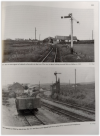Andreas
Registered
Hello everyone,
I would like to build a simple signal system on my railroad. I don't want it to be true to the original - just not completely wrong, of course.
My layout represents an Irish branch line from the 50s. Although it is set in the present day. Somehow time has stood still.
I would like to place a wing signal at the exit of each of the 3 tracks in the station.
NOW MY QUESTION
How should the signals be set? (I am using old American LGB signals that have been given new wings) KLICK
Do the signals have to be to the right or left of the track and in which direction does the signal wing point?
Tanks
Andreas
Translated with DeepL.com (free version)
I would like to build a simple signal system on my railroad. I don't want it to be true to the original - just not completely wrong, of course.
My layout represents an Irish branch line from the 50s. Although it is set in the present day. Somehow time has stood still.
I would like to place a wing signal at the exit of each of the 3 tracks in the station.
NOW MY QUESTION
How should the signals be set? (I am using old American LGB signals that have been given new wings) KLICK
Do the signals have to be to the right or left of the track and in which direction does the signal wing point?
Tanks
Andreas
Translated with DeepL.com (free version)

